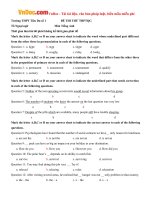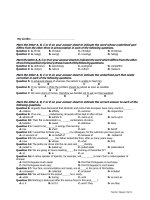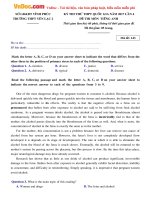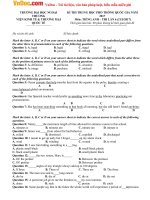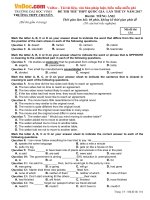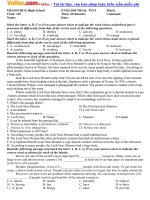Đề thi thử THPT Quốc gia năm 2017 môn Tiếng Anh trường THPT Chu Văn An, Yên Bái CÓ ĐÁP ÁN
Bạn đang xem bản rút gọn của tài liệu. Xem và tải ngay bản đầy đủ của tài liệu tại đây (131.3 KB, 6 trang )
ĐỀ THI THỬ TRUNG HỌC PHỔ THÔNG QUỐC GIA NĂM 2017
MÔN: TIẾNG ANH
Thời gian làm bài: 60 phút, không kể thời gian phát đề ( Đề thi gồm có: 05 trang)
Mark the letter A, B, C, or D on your answer sheet to indicate the word whose underlined part differs
from the other three in pronunciation in each of the following questions.
Question 1: A. provide
B. problem
C. psychologist
D. overpopulated
Question 2: A. interrupted
B. complicated
C. finished
D. needed
Mark the letter A, B, C or D on your answer sheet to indicate the word that differs from the rest in the
position of the main stress in each of the following questions.
Question 3: A. symbolic
B. popular
C. dimension
D. pollution
Question 4: A. enter
B. supply
C. allow
D. begin
Mark the letter A, B, C or D on your answer sheet to show the underlined part that needs correction
in each of the following questions.
Question 5: It is necessary that she stays in bed for a few days before
A
B
C
going back to school.
D
Question 6: Fiorello La Guardia made a speech to the United Nations Relief Administration,
A
when he was the director, stating that Europe did not experience prosperity after World War II.
B
C
D
Question 7: Psychologist Abraham Maslow argued that humans have unique desires to
A
B
discover and understand, the giving of love to others, and to fulfill their inner potential.
C
D
Mark the letter A, B, C or D on your answer sheet to indicate the correct answer to each of the
following questions.
Question 8: In most social situations where some _________ is allowed, a brief raise of the hand and a
small wave is fine to attract someone attention.
A. informality
B. friendship
C. familiarity
D. introduction
Question 9: People ___________how to dye their clothes even before they knew how to read and
write.
A. have known
B. had known
C. knew
D. are known
Question 10: She finally admitted that she broke the pot ____________.
A. purposefully
B. clumsily
C. willingly
D. deliberately
Question 11: The strike was ____________ owing to a last-minute agreement with the management.
A. called off
B. broken up
C. set back
D. put down
Question 12: We _______________ today and I got into trouble because I hadn’t done it.
A. had checked our homework
B. had our homework checked
C. were checked our homework
D. have our homework checking
Question 13: Military is _____________ in this country. Every man who reaches the age of 18 has to
serve in the army for two years.
A. compulsory
B. optional
C. illegal
D. unnecessary
Question 14: Going on this diet has really __________ me good. I’ve lost weight and I feel fantastic.
A. made
B. taken
C. done
D. had
Question 15: They _________ have seen the play last night as they went to a football match instead.
A. couldn’t
B. mustn’t
C. might
D. can’t
Question 16: David learned to play _________ violin when he was at ______ university.
A. a/a
B. the/ X
C. the/the
D. X/the
Question 17: There are several means of mass communication. The newspaper is one. Television is
_________
A. another
B. other
C. the another
D. the other
Question 18: Several ..................sleeping under a tree
A. of lions were
B. lion was
C. of the lions was
D. lions were
Question 19: My friend Mary is a blabbermouth! She can’t resist __________everyone what she heard
from me.
A. tell
B. to tell
C. telling
D. to telling
Question 20: Customer: “Can I have a look at that pullover, please?”
Salesgirl: “ ______________”
A. Which one? This one?
B. It’s much cheaper
C. Sorry, it is out of stock
D. Can I help you?
Question 21: Johnson: “ I’m afraid I can’t come with you”
Barbara: “____________________ !”
A. What a shame
B. What pity
C. Be patient
D. That’s a shame
Mark the letter A, B, C, or D on your answer sheet to indicate the word(s) CLOSEST in meaning to
the underlined word(s) in each of the following questions.
Question 22: You may find that jogging is detrimental to your health rather than beneficial.
A. depressing
B. facile
C. helpful
D. harmful
Question 23: We had to list the chronology of events in World War II on our test.
A. time sequence
B. discrepancy
C. catastrophe
D. disaster
Mark the letter A, B, C, or D on your answer sheet to indicate the word(s) OPPOSITE in meaning
to the underlined word(s) in each of the following questions.
Question 24: The power failure at dinnertime caused consternation among the city’s housewives.
A. anxiety
B. calm
C. dismay
D. deliberation
Question 25: We all looked up to these fire fighters who put out the terrible fire in our town last night.
A. looked into
B. respected
C. looked down on
D. admired
Mark the letter A, B, C or D on your answer sheet to indicate the sentence that is correct and closest
in meaning to each of the following questions.
Question 26: He’s been studying for so many years that he should have realized sooner that his
grammar was incorrect.
A. He has been a student for so long that he could quickly tell when his grammar was incorrect.
B. A student of his experience ought to have noticed his incorrect grammar earlier.
C. The student would have known that his grammar was incorrect if he’d had more experience.
D. The grammar wouldn’t have been so problematic if the student had been aware of it sooner.
Question 27: Twice as many women as men work as English teachers.
A. Female English teachers outnumber male ones.
B. More women than men have English teachers.
C. English is twice as much difficult to teach women as men.
D. Women are twice as likely as men to teach English.
Question 28: “Susan , can you remember to buy me some sugar ? ” said Billy .
A. Billy advised Susan to buy him some sugar .
B. Billy promised to buy Susan some sugar
C. Billy reminded Susan to buy him some sugar
D. Billy pleaded with Susan to buy him some sugar
Mark the letter A, B, C, or D on your answer sheet to indicate the sentence that best joins each of
the following pairs of sentences in each of the following questions.
Question 29: You need not have washed the sheets. The hotel staff does the cleaning.
A. It is advised that the hotel staff wash the sheets.
B. It was not necessary to wash the sheets, even though you did.
C. It was necessary to wash the sheets, but you did not do it.
D. It was not necessary to wash the sheets; and therefore you did not do it.
Question 30: He spent all his money. He even borrowed some from me.
A. As soon as he borrowed some money from me, he spent it all.
B. Hardly had he borrowed some money from me when he spent it all.
C. Not only did he spend all his money but also he borrowed some from me.
D. Not only did he spend all his money but he borrowed some from me as well..
Read the following passage and mark the letter A, B, C, or D on your answer sheet to choose the
word or phrase that best fits each of the following blanks
Here are some advice for trying to find the university that works for you.
You need to examine yourself and your reason for going to university before you start your
rearch. Why are you going? What are your abilities and strengths? What are your weaknesses? What do
you want out of life? Are you socially self-sufficient (31)_________ do you need warm, familial
support ? Talk with your family, friends and high-school counselors as you ask these questions. The
people (32) __________ know you best can help you the most with these important issues.
Very few high-school students have enough information or (33)__________ to choose a major.
You need to be well- prepared to determine your interest and aptitude. Many students (34) ___________
their minds two or three times before they settle on a major.
If you do not have to go to university right away it is never too late. There is no such thing as the
perfect time to start university. Some students benefit from a year off to work, study or travel, and these
experiences (35) ________ them to be better, more engaged students. Some students choose to apply to
university and gain admission and then defer their entrance, while others wait to apply until after they
have had an alternative experience.
Question 31: A. or
B. but
C. nor
D. either
Question 32: A. which
B. whom
C. who
D. whose
Question 33: A. expenditure B. experiences
C. experiment
D. expert
Question 34: A. transform
B. translate
C. change
D. convert
Question 35: A. allow
B. make
C. let
D. advise
Read the following passage and mark the letter A, B, C, or D on your answer sheet to indicate the
correct answer for each of the questions from 36 -42.
Crows are probably the most frequently met and easily identifiable members of the native fauna
of the United States. The great number of tales, legends, and myths about these birds indicates that
people have been exceptionally interested in them for a long time. On the other hand, when it comes to
substantive -particularly behavioral - information, crows are less well known than many comparably
common species and, for that matter, not a few quite uncommon ones: the endangered California
condor, to cite one obvious example. There are practical reasons for this.
Crows are notoriously poor and aggravating subjects for field research. Keen observers and quick
learners, they are astute about the intentions of other creatures, including researchers, and adept at
avoiding them. Because they are so numerous, active, and monochromatic, it is difficult to distinguish
one crow from another. Bands, radio transmitters, or other identifying devices can be attached to them,
but this of course requires catching live crows, who are among the wariest and most untrappable of
birds.
Technical difficulties aside, crow research is daunting because the ways of these birds are so
complex and various. As preeminent is generalists, members of this species ingeniously exploit a great
range of habitats and resources, and they can quickly adjust to changes in their circumstances. Being so
educable, individual birds have markedly different interests and inclinations, strategies and scams. For
example, one pet crow learned how to let a dog out of its kennel by pulling the pin on the door. When
the dog escaped, the bird went into the kennel and ate its food.
Question 36: What is the main topic of the passage?
A. The ways in which crows differ from other common birds
B. The myths and legends about crows
C. The characteristics that make crows difficult to study
D. The existing methods for investigating crow behavior
Question 37: The word 'comparable' in line 5 is closest in meaning to
A. interestingly
B. similar
C. otherwise
D. sometimes
Question 38: In line 6, the author mention the endangered California condor as an example of a species
that is .......................................
A. smaller than the crow B. easily identifiable
C. featured in legends
D. very rare
Question 39: According to the second paragraph, crows are poor subjects for field research for all of the
following reasons EXCEPT
A. They can successfully avoid observers.
B. They are hard to distinguish from one another
C. They can be quite aggressive.
D. They are difficult to catch.
Question 40: According to the third paragraph, which of the following is true about crows?
A. They seldom live in any one place for very long.
B. They thrive in a wide variety of environments.
C. They have marked preferences for certain kinds of foods.
D. They use up the resources in one area before moving to another.
Question 41: In line 19,the word 'inclinations' is closest in meaning to ........................................
A. tricks
B. opportunities
C. preferences
D. experiences
Question 42: Which of the following statements is supported by the passage?
A. Crows have relatively long lives.
B. Crows have keen vision
C. Crows are usually solitary
D. Crows are very intelligent.
Read the following passage and mark the letter A, B C, or D on your answer sheet to indicate the
correct answer for each of the questions from 43 – 50.
Botany, the study of plants, occupies a peculiar position in the history of human knowledge. For
many thousands of years it was the one field of awareness about which humans had anything more than
the vaguest of insights. It is impossible to know today just what our Stone Age ancestors knew about
plants, but from what we can observe of pre-industrial societies that still exist, a detailed learning of
plants and their properties must be extremely ancient. This is logical. Plants are the basis of the food
pyramid for all living things, even for other plants. They have always been enormously important to the
welfare of peoples , not only for food, but also for clothing, weapons, and tools: medicines; shelter, and
a great many other purposes. Tribes living today in the jungles of the Amazon recognized literally
hundreds of plants and know many properties of each. To them botany, as such, has no name and is
probably not even recognized as a special branch of “Knowledge” at all.
Unfortunately, the more industrialized we become the farther away we move from direct contact
with plants, and the less distinct our knowledge of botany grows. Yet everyone comes unconsciously on
an amazing amount of botanical knowledge, and few people will fail to recognize a rose, an apple, or an
orchid. When our Neolithic ancestors, living in the Middle East about 10,000 years discovered that
certain grasses could be harvested and their seeds planted for richer yields the next season, the first great
step in a new association of plants and humans was taken. Grains were discovered and from them
flowed the marvel of agriculture: cultivated crops. From them on, humans would increasingly take their
living from the controlled production of a few plants, rather than getting a little here and a little there
from many varieties that grew wild – and the accumulated knowledge of tens of thousands of years of
experience and intimacy with plants in the wild would begin to fade away.
Question 43: How is the term “botany” is explained in the passage?
A. It is a study of leaves
B. It is a science of nature
C. It is the study of plants
D. It is research on various types of trees
Question 44: The word “properties” in paragraph 1 means ………………………..?
A. lands
B. knowledge
C. possessions
D. Characteristics
Question 45: What does the comment “This is logical” in paragraph 1 mean?
A. There is no clear way to determine the extent of our ancestor’s knowledge of plants
B. It is not surprising that early humans had a detailed knowledge of plants
C. It is reasonable to assume that our ancestors behaved very much like people in pre- industrial
societies
D. Human knowledge of plants is well organized and very detail
Question 46: Why does the author mention “a rose, an apple, or an orchid”?
A. to make the passage more poetic
B. to cite examples of plants that are attractive
C. to give botanical examples that all readers will recognize
D. to illustrate the diversity of botanical life
Question 47: According to the passage, what was the first great step toward the practice of agriculture?
A. The invention of agricultural implements and machinery
B. The development of a system of names for plants
C. The discovery of grasses that could be harvested and replanted
D. The changing diets of early humans
Question 48: What is the relationship between botany and agriculture similar to?
A. the relationship between zoology and deer hunting
B. The relationship between zoology and bird watching
C. The relationship between zoology and sheep raising
D. The relationship between zoology and horseback riding
Question 49: In which lines in the passage does the author describe the beneficial properties that plants
have for humans?
A. Lines 1-2
B. Lines 6- 9
C. Lines 11-12
D. Lines 14-16
Question 50: Which of the following is NOT mentioned as use of plants?
A. for food
B. for jewelries
C. for clothes
D. for weapons
The end
ĐÁP ÁN- THANG ĐIỂM
ĐỀ THI THỬ KỲ THI THPT QUỐC GIA (NĂM 2016- 2017)
Môn: Tiếng Anh
1
2
3
4
5
6
7
8
9
10
C
C
B
A
B
A
C
A
B
D
11
12
13
14
15
16
17
18
19
20
A
B
A
C
D
B
A
D
C
A
21
22
23
24
25
26
27
28
29
30
A
D
A
B
C
B
A
C
B
D
31
32
33
34
35
36
37
38
39
40
A
C
B
C
A
C
B
D
C
B
41
42
43
44
45
46
47
48
49
50
C
D
C
D
B
C
C
C
B
B
(Mỗi câu đúng được 0.2 điểm)

